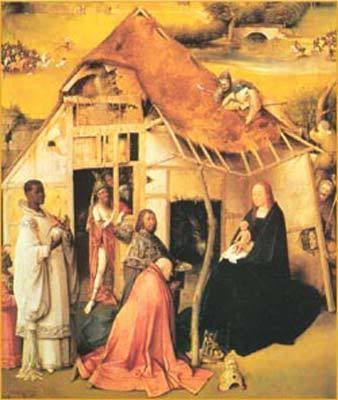cross posted in part at The Dream Antilles

“Cuando Jesús nació en Belén de Judea en días del rey Herodes, vinieron del oriente a Jerusalén unos magos diciendo: ¿Dónde está el rey de los judíos, que ha nacido? Porque su estrella hemos visto en el oriente y venimos a adorarle. Oyendo esto, el rey Herodes se turbó, y toda Jerusalén con él. Y convocados todos los principales sacerdotes, y los escribas del pueblo, les preguntó dónde había de nacer el Cristo. Entonces Herodes, llamando en secreto a los magos, indagó de ellos diligentemente el tiempo de la aparición de la estrella; y enviándolos a Belén. Ellos, habiendo oído al rey, se fueron. Y al entrar en la casa, vieron al niño con su madre María, y postrándose lo adoraron; y abriendo sus tesoros, le ofrecieron presentes: oro, incienso y mirra. Pero siendo avisados por revelación en sueños que no volviesen a Herodes, regresaron a su tierra por otro camino.” (San Mateo 2, 1-12).
(This is easy to read, even if you have only the most basic Spanish or other Romance Language, it’s Matthew 2, 1-12. It’s also great in English.)
January 6 is Three Kings Day (Tres Reyes Magos or Epiphany). The holiday commemorates the day the Three Kings from the East, after following the star for twelve days, arrived in Bethlehem to find the child in the manger and to give symbolic gifts of frankincense, myrrh and gold. Three Kings Day is the day on which gifts are traditionally given throughout Central and South America.
Only relatively recently has globalization and commercialization brought Santa Claus and Christmas trees and gift giving on Christmas Day. Before that, the Three Kings came with the gifts only on January 6, twelve days after Christmas. According to this Wiki:
In Spain, Argentina, and Uruguay, children (and many adults) polish and leave their shoes ready for the Kings’ presents before they go to bed on the 5th of January. Sweet wine, nibbles, fruit and milk are left for the Kings and their camels. In Mexico, it is traditional for children to leave their shoes on the eve of January 6 by the family nativity scene or by their beds. Also a letter with toy requests is left and sometimes the shoes are filled with hay for the camels, so that the Kings will be generous with their gifts. In Puerto Rico, it is traditional for children to fill a box with grass or hay and put it underneath their bed, for the same reasons. In some parts of northern Mexico the shoes are left under the Christmas tree with a letter to the Three Kings. This is analogous to children leaving mince pies or cookies and milk out for Father Christmas in Western Europe.
If you consider the Three Kings Story from a mythic, rather than a religious perspective, it’s a very important allegory about the wise, eastern Kings’ faithfully following their instinct and knowledge across the desert to the place it led them (did they know where they were going?) and when they reached the destination giving their gifts to those they found who should receive them. I really like that. I like to think about the kind of courage and understanding one would need to have to play the role of the kings (the wise men) in the story. Would I follow my star? Would I persist for 12 days? Would frustration, despair, fear stop my journey? Would I realize when I had arrived? Would I know what gifts to give and to whom?
Feliz Dia de Reyes!
